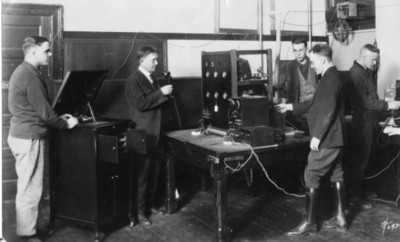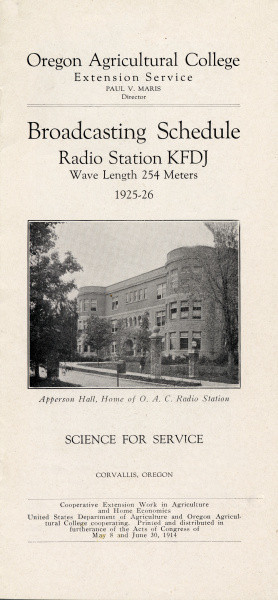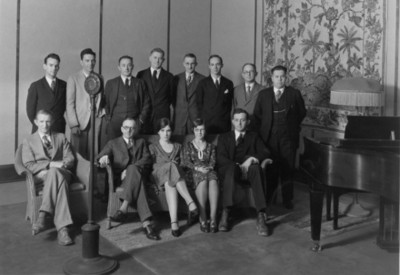The radio now breaks down the barriers of time and space and opens the way to extend immeasurably this type of teaching and of service. Without cost, without loss of time, within your own home, you may select from the programs here presented, lectures and combinations of lectures, which relate to your personal problems and interest, and which, if closely followed, will contribute to your service and personal improvement.
—Paul Maris, KOAC radio programs: 1925-1926

The first KOAC radio transmitter (then KFDJ) was built in 1922 by Physics professor Jacob Jordan and was located in Apperson Hall. Jordon is the second person from the left.The first KOAC radio transmitter (then KFDJ) was built in 1922 by Physics professor Jacob Jordan and was located in Apperson Hall. Jordon is the second person from the left.
In the early 1920s, the Oregon Extension Service took a note from its own lesson books and found ways to use science and technology to make their program more efficient. While county Extension agents were becoming an invaluable part of Oregon’s agricultural economy, there were only so many places they could be at once. New radio technology, however, promised to solve that problem by bringing daily broadcasts through the air and into the homes of every Oregonian with a receiver. Under the leadership of OAC’s Director of Information, Wallace Kadderly, the staff in the department of physics built a 50 watt radio station in the Apperson Hall physics lab. OAC was granted a broadcasting license for radio station KFDJ on December 7, 1922, and formal educational program broadcasting began in March of 1923. Following their slogan of “Science for Service,” by 1925 the station was running regular programs on agriculture and home economics topics ranging from “Repair and Adjustment of Farm Machinery” and “Preparing Lambs for Market” to “The Cooking and Serving of Fall Vegetables” and “The Three R’s of Dressing Attractively.” Additionally, regular music programs, 4-H Club presentations, campus football and basketball games, intercollegiate debates, and commencement exercises were covered as special events.
The success of the KFDJ broadcasts encouraged the station to expand, boosting their signal to 500 watts in August of 1925 and again to 1,000 watts in November of 1928. To reflect their statewide reach, in December of 1925 KFDJ changed its call signal to KOAC and expanded its programming. By 1930, the project had grown from a 50 watt physics experiment that transmitted intermittent broadcasts to having a dedicated staff of Kadderly, his two full time assistants, and 15 part-time staff who assisted in announcement, manuscript preparation, and program consultation. With the additional staff, the programming of the station expanded from 313 programs in 1925 to 2,130 separate presentations merely five years later in 1930.


